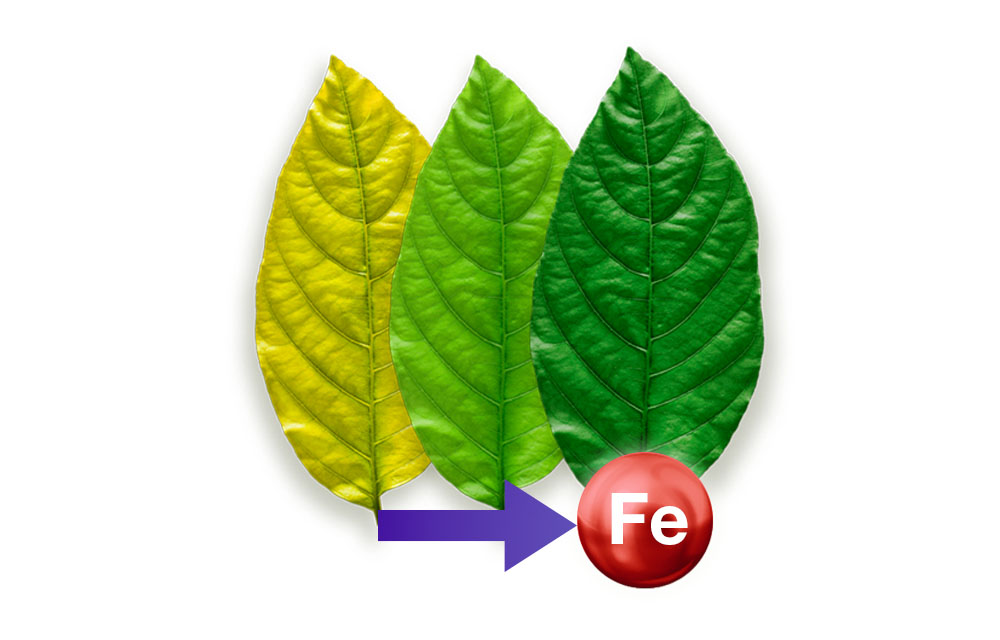Iron in plants: the importance of making it available to correct iron chlorosis

Iron chlorosis in citrus
Iron is an essential micronutrient for plant development. It plays a key role as it is involved in the synthesis of chlorophyll and in other enzymatic and metabolic processes without which plants cannot carry out their lifecycle.
Iron deficiency is manifested by iron chlorosis, which is not caused by a lack of iron in the soil but rather its low availability in a form that can be absorbed by the plant. Addressing this problem calls for strategies that combine the use of high-quality, highly soluble and stable iron chelates, such as those marketed by Seipasa, as well as the additional use of other solutions that stimulate root development, which are recommended to improve the absorption of key micronutrients.
Iron in plants has the main function of generating chlorophyll. Lack of iron causes yellowing in young leaves due to the plant not being able to produce chlorophyll. If iron chlorosis becomes more severe this loss of colour can also affect adult leaves. In time, it may result in leaf necrosis, drying out and the leaves dropping, which in turn eventually affects production too.
As previously mentioned, iron chlorosis is not caused by a lack of iron in the soil but rather because the iron is in a form that the plant cannot absorb. Iron is one of the most abundant elements on the planet. It is present in most soils, but in an insoluble, "locked" form, which plant roots cannot absorb.
Plants are not able to take up iron in soils with a high concentration of carbonates and bicarbonates that reduce its solubility and mobility. Soil pH determines availability of iron and of the rest of micronutrients to plants. The amount of absorbable iron decreases as soil alkalinity increases, so the more acid a soil is the greater the amount of iron available to plants will be.
It is difficult to change soil pH so, in practice, iron chelates must be applied. In this regard it is important to highlight that not just any type of fertilizer based on iron salts can be used, as it precipitates quickly and would only increase the already plentiful presence of iron in the soil, but not in soluble form.
Iron chelates: when and why
Iron chelates are compounds in which an organic molecule envelops and binds with a metal ion, protecting it and preventing it from precipitating. The accompanying chelating agent is responsible for this action, enabling the iron to remain in a soluble form, in which it is available for absorption by the plant.
The key in the way an iron chelate acts is its stability, which determines the degree of protection that the chelating agent provides for the metal it contains. To this end Seipasa has designed a range of soil solutions that offer maximum quality and efficacy.
The Gresca ID Hierro line consists of EDDHA-type iron chelates that are highly stable in a pH range of between 3.5 and 10. In addition, the ortho-ortho positional isomer increases stability, by providing greater protection for the iron molecules in high pH soil environments. Compared to other types of chelates and positional isomers, the Gresca ID Hierro line, with 5.0 and 5.3 guaranteed contents, ensures quick availability and persistence of absorbable iron in the soil: the full percentage of iron in the Gresca line is absorbable. These products provide maximum efficiency and efficacy in calcareous soils as well as easier uptake and transport of iron in the plant.
Combination with root biostimulants
The combination of the Gresca ID Hierro line with the Radisei root biostimulant enhances the process of absorption through plant roots and root hairs. Radisei is an exclusive formulation by Seipasa, registered with the Spanish Ministry of Agriculture, Fisheries and Food, which contains its own strain of Bacillus subtilis that stimulates the development of the root system through the growth of secondary roots and absorbent hairs, while enhancing the absorption of key elements like iron.
The iron chelate helps increase iron solubilisation and its transport towards the plant roots, while Radisei improves the roots' capacity to absorb this essential micronutrient and to make it available to the plant for the development of key functions.
It is, however, important to remember that while iron chelates prevent iron chlorosis they do not resolve soil problems and so they need to be applied periodically.



